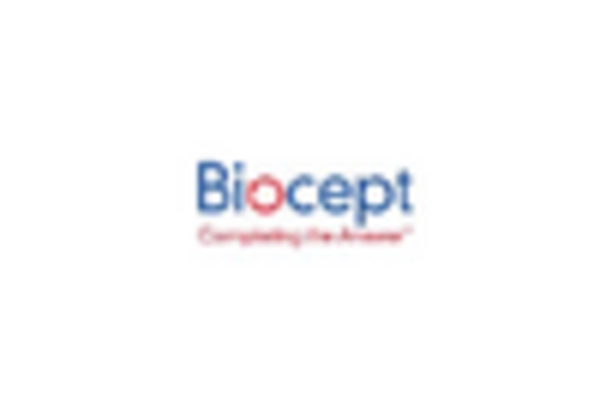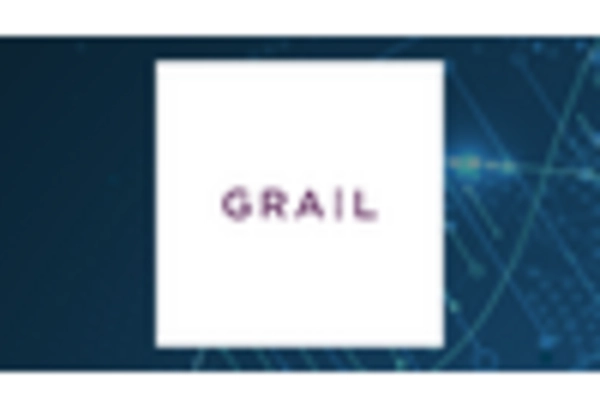Rising Incidence of Cancer
The increasing incidence of cancer in Germany is a primary driver for the circulating tumor-cell market. According to recent statistics, cancer cases are projected to rise by approximately 5% annually, leading to a heightened demand for innovative diagnostic solutions. This trend is particularly evident in urban areas, where lifestyle factors contribute to higher cancer rates. As healthcare providers seek to improve early detection and monitoring of cancer, the circulating tumor-cell market is likely to experience significant growth. The ability to detect cancer at an early stage can potentially enhance treatment outcomes, thereby driving investments in research and development within this industry. Furthermore, the German healthcare system's focus on improving patient outcomes aligns with the increasing need for advanced diagnostic tools, suggesting a robust market environment for circulating tumor-cell technologies.
Regulatory Framework Enhancements
The evolving regulatory landscape in Germany is influencing the circulating tumor-cell market positively. Recent reforms aimed at expediting the approval process for innovative diagnostic tools have created a more conducive environment for market entry. The German Medicines Agency has streamlined procedures, allowing for faster access to market for circulating tumor-cell technologies. This regulatory support is crucial for companies seeking to introduce novel products, as it reduces time-to-market and associated costs. Furthermore, the emphasis on patient safety and efficacy ensures that only high-quality products are available, thereby enhancing consumer confidence in circulating tumor-cell diagnostics. As regulatory frameworks continue to evolve, they are likely to facilitate the growth of the market, encouraging more players to invest in this promising sector.
Increasing Awareness and Education
Raising awareness about the importance of early cancer detection is driving the growth of the circulating tumor-cell market. Educational initiatives aimed at both healthcare professionals and the general public are becoming more prevalent in Germany. These programs emphasize the benefits of liquid biopsies and circulating tumor-cell analysis in improving patient outcomes. As awareness increases, more patients are likely to seek out advanced diagnostic options, thereby expanding the market. Additionally, healthcare providers are becoming more informed about the capabilities of circulating tumor-cell technologies, leading to greater adoption in clinical practice. This shift in perception is expected to create a more favorable market environment, as demand for innovative diagnostic solutions continues to rise. The focus on education and awareness is likely to play a pivotal role in shaping the future of the circulating tumor-cell market.
Growing Investment in Cancer Research
Investment in cancer research is a significant driver for the circulating tumor-cell market. In Germany, public and private funding for cancer research has seen a substantial increase, with expenditures reaching approximately €1 billion annually. This financial support fosters innovation in diagnostic and therapeutic approaches, particularly in the realm of circulating tumor-cell technologies. Research institutions and biotech companies are collaborating to develop novel solutions that can improve patient outcomes. The emphasis on translational research, which bridges laboratory findings with clinical applications, is likely to enhance the relevance of circulating tumor-cell technologies in clinical settings. As the demand for effective cancer treatments continues to rise, the influx of research funding is expected to stimulate advancements in the circulating tumor-cell market, creating a favorable environment for growth and development.
Advancements in Diagnostic Technologies
Technological innovations in diagnostic methodologies are propelling the growth of the circulating tumor-cell market. The introduction of highly sensitive assays and imaging techniques has revolutionized cancer diagnostics, allowing for the detection of circulating tumor cells with unprecedented accuracy. In Germany, the market for liquid biopsy technologies, which include circulating tumor-cell analysis, is expected to reach €500 million by 2026. These advancements not only facilitate earlier diagnosis but also enable real-time monitoring of treatment efficacy. As healthcare providers increasingly adopt these technologies, the circulating tumor-cell market is poised for expansion. Moreover, the integration of artificial intelligence in data analysis further enhances the capabilities of diagnostic tools, indicating a promising future for the industry. The continuous evolution of these technologies suggests that the market will remain dynamic and responsive to the needs of healthcare professionals.
















Leave a Comment